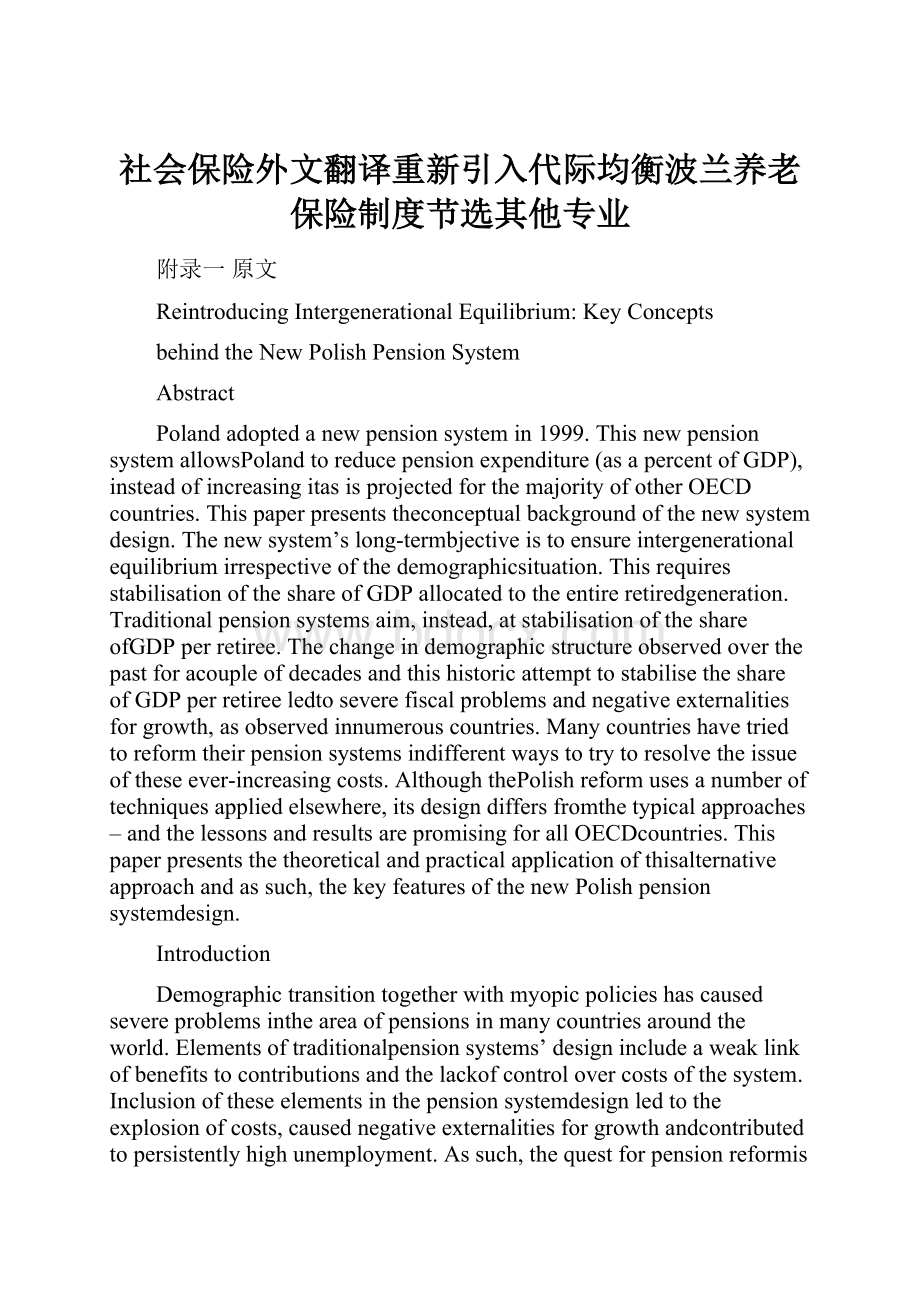社会保险外文翻译重新引入代际均衡波兰养老保险制度节选其他专业.docx
《社会保险外文翻译重新引入代际均衡波兰养老保险制度节选其他专业.docx》由会员分享,可在线阅读,更多相关《社会保险外文翻译重新引入代际均衡波兰养老保险制度节选其他专业.docx(10页珍藏版)》请在冰豆网上搜索。

社会保险外文翻译重新引入代际均衡波兰养老保险制度节选其他专业
附录一原文
ReintroducingIntergenerationalEquilibrium:
KeyConcepts
behindtheNewPolishPensionSystem
Abstract
Polandadoptedanewpensionsystemin1999.ThisnewpensionsystemallowsPolandtoreducepensionexpenditure(asapercentofGDP),insteadofincreasingitasisprojectedforthemajorityofotherOECDcountries.Thispaperpresentstheconceptualbackgroundofthenewsystemdesign.Thenewsystem’slong-termbjectiveistoensureintergenerationalequilibriumirrespectiveofthedemographicsituation.ThisrequiresstabilisationoftheshareofGDPallocatedtotheentireretiredgeneration.Traditionalpensionsystemsaim,instead,atstabilisationoftheshareofGDPperretiree.ThechangeindemographicstructureobservedoverthepastforacoupleofdecadesandthishistoricattempttostabilisetheshareofGDPperretireeledtoseverefiscalproblemsandnegativeexternalitiesforgrowth,asobservedinnumerouscountries.Manycountrieshavetriedtoreformtheirpensionsystemsindifferentwaystotrytoresolvetheissueoftheseever-increasingcosts.AlthoughthePolishreformusesanumberoftechniquesappliedelsewhere,itsdesigndiffersfromthetypicalapproaches–andthelessonsandresultsarepromisingforallOECDcountries.Thispaperpresentsthetheoreticalandpracticalapplicationofthisalternativeapproachandassuch,thekeyfeaturesofthenewPolishpensionsystemdesign.
Introduction
Demographictransitiontogetherwithmyopicpolicieshascausedsevereproblemsintheareaofpensionsinmanycountriesaroundtheworld.Elementsoftraditionalpensionsystems’designincludeaweaklinkofbenefitstocontributionsandthelackofcontrolovercostsofthesystem.Inclusionoftheseelementsinthepensionsystemdesignledtotheexplosionofcosts,causednegativeexternalitiesforgrowthandcontributedtopersistentlyhighunemployment.Assuch,thequestforpensionreformisnowonthetopofpolicyagendasaroundtheworld,andespeciallyinEurope.However,veryfewcountrieshavebeenabletointroducefundamentalreformsintheareaofpensionstothistime.Inthiscase,thedefinitionofreformiscrucial.Forthepurposesofthispaper,“reform”meanschangingthesysteminordertoremovetructuralinefficiencies–andnotjustplayingatthemarginswithcontributionratesandretirementagestoadjustthesystem’sparametersforshort-termfiscalandpoliticalreasons.Traditionalpensionsystemshaveproventobeinefficientinprovidingsocietieswithsocialsecurity.Atthesametimeattemptstocurethesesystemsarehamperedbyalackofconsensusonwhatcouldreplacethetraditionalsystem.Discussionsonthisissueinvolveconfusionstemmingfromtheideologicalcontextofthediscussionparticipants,aswellasfromoveruseofsuchconceptsas“pay-as-you-go”versus“funding”,or“public”versus“private”,whileatthesametimeignoringanumberofimportanteconomicissues.
Furthermore,economistshavetraditionallyignoredpensions.Designingandrunningpensionsystemswaslefttonon-economists,whowerenotextensivelyconcernedwithhowtofinancepensionsinthelong-termorwithhowtocounteractthesepensionsystems’negativeexternalities.ThenewPolishpensionsystembelongstoverysmallnumberofsuccessfulattemptstoapplymodernthinkingintheareaofpensions.Thisdoesnotmean–assomemayassume–givingupsocialsecuritygoals.Rather,thekeyideawastogiveuptheinefficientmethodsofdeliveringsocialsecurityinordertosaveitsgoalsandprinciples.
Thispaperconsistsoftwoparts.Thefirstfocusesonadiscussionofgeneralissuesthatneedtobeaddressedwhendesigningapensionsystem.Theseissuesarepresentedinawaythatgoesbeyondthetraditionalwayofthinkingonpensions.Inregardstothissecondpartofthepaper,itisimportanttopointoutthatmostcountriesinthecurrentEUmemberstatesandcandidatecountrieshavepensionsystemsthatareessentiallythesameatthebasicpolicylevel.Assuch,thesolutionsinonememberstateorcandidatecountrycanbeexpectedtobethesame.LikeEuropeanstatessuchasFrance,Germany,Italy,theCzechRepublic,HungaryandotherEuropeanstates,PolandandSwedenoverthepastdecadesanduntilthelate1990’sdevelopedinefficient,costlypensionsystems.Assuch,inparttwoofthepaperweshallexaminehowPolandhasnowsuccessfullyimplementedtheapproachpresentedinthefirstpartofthepaper,andcreatedafundamentallystrongandneutralpensionsystem.
Selectedgeneralissues
Pensionsystemdesignhastotakeintoaccountanumberofissues.TheirfullpresentationanddiscussiongoesbeyondthescopeofthispaperThispaperpresentsonlyalistoftheissuesforconsiderationandthemostimportantobservations.Thepensionsystem:
externalitiesversusneutralityThedescriptionofapensionsystemdependsstronglyonboththeaggregatedandindividualviewpoint.Fromtheaggregatedperspective,thepensionsystemisawayofdividingcurrentGDPbetweenapartkeptbytheworkinggenerationandapartallocatedtotheretiredgeneration.Fromtheindividualperspective,thepensionsystemisawayofincomeallocationoveraperson’slifecycle.Theaboveholdsirrespectivetothetechnicalmethodappliedortheideologicalviewpoint.Thepensionsystem–asdefinedabove–isnotnecessarilypay-as-you-goorfunded.Suchfeaturesstemfromtechnicalelementsadditionallyappliedonthetopofthepensionsystem,ratherthanfromthesystemitself.Ifthepensionsystemdesignassumesanonymousparticipationandasubstantialscaleofredistributionthenweusuallycallthissystempay-as-you-go.Ifthepensionsystemdesignusesfinancialmarkets,thenweusuallycallitfunded.However,thesetwotypicallyusedconceptsdonotexhaustallpossiblecombinationsofanonymousversusindividualisedparticipationandfinancialversusnon-financialpensionsystemdesigntechniquesused.Thedualisticpay-as-you-goversusfundedapproachleavesasidethecombinationofindividualparticipationinasystemthatdoesnotusefinancialmarkets.Thisapproachalsoneglectsthefactthatusingfinancialmarketsmeansinvestment(pensionportfolioconsistsofprivateequities)ordeferringtaxes(pensionportfolioconsistsofgovernmentbonds),whichisobviouslynotthesame.Addingredistributionorfinancialmarketstothepensionsystemgeneratesexternalities.Theseexternalitiescanbepositiveandnegative.Redistributionwithinthepensionsystemcangeneratepositiveexternalitiesifthesystemisinexpensive,namelythepartofGDPallocatedtotheretiredgenerationisnotlarge.Iftheredistributionislarge,thenitgeneratesnegativeexternalities,suchascontributingtopersistentlyhighunemploymentandweakgrowth.Usingfinancialmarketscausespositiveexternalitiesforgrowthifthepensionsystemspendscontributionmoneyoninvestment.Ifthecontributionsarespentongovernmentdebttheymayleadtonegativeexternalitiessimilartothoseoflargeredistributivesystem,namelymoretaxdistortions.ThiscanhappeniftherateofreturnongovernmentdebtispersistentlyabovetherateofGDPgrowth.Thereexistsyetanotheroption,namelytobringthepensionsystemasclosetoeconomicneutralityaspossible.Thisoptionrequires,amongotherthings,combiningindividualparticipationinthesystemwithdividingGDPbetweengenerationsbasedonrealeconomydevelopments,suchashasbeendoneinPolandandSweden.
Demographicstructure:
consequencesofthechange.Irrespectiveofthepensionsystemdesigntechniqueused,thepensionsystemexchangesarightoftheretiredgenerationforapartoftheproductoftheworkinggeneration.Theexchangecanbeorganisedinvariouswaysandalsotherightscanbeexpressedinvariousways.Inparticular,therightscanbeeithertradedinthefinancialmarkets,ordefinedinrelationtosomeeconomicvariables,orjustbasedonpoliticalpromise.Inallofthesecasesthereisakindofmarketforpensionrights.Theworkinggenerationfinancescontributionsinordertopurchasetherights;theretiredgenerationsellstherightsinordertogetapartoftheproductoftheworkinggeneration.Thevarioustypesofpensionsystemscreateaninstitutionalframeworkforthismarket.
KeyfeaturesofthenewPolishpensionsystem
ThenewPolishpensionsystemdesignisagoodexampleofapplyingtheabovedescribedwayofthinkinginpractice.Thesystemnamed“SecuritythroughDiversity”startedon1January1999.Itentirelyreplacedpreviousregulationsonoldagepensionsformajorityofworkingpopulation.Designingthenewsystemfromscratchprovidedtheuniqueopportunitytoavoidcomplicatingthesystem.Instead,thenewsystemdesignissimpleandtransparent.Themaingoalwastodesignasystemthatcanbeneutraloratleastclosetoneutralityforeconomicgrowthirrespectiveofpopulationageing.Thedesignofthenewsystemdoesnotcopyanyotherpensionsystemexistingelsewhere.StrongsimilaritycanbefoundonlytothenewSwedishpensionsystembasedonsimilarprinciplesandstartedonthesameday.16Atthesametime,withinthisgeneralframeworkthenewPolishsystemusesanumberoftechnicalconceptsdevelopedinothercountries.ThisbriefpresentationofthenewPolishpensionsystemfocusesonthegeneraleconomicdesignofthesystem,whileleavingasidemosttechnicaldetails.
ThefollowingbulletshelpingraspingtheessenceoftheconceptofthenewPolishsystemdesign.
Focusingontheuniversalpartofthepensionsystem;
Separationoftheold-agepartofsocialsecurityfromthenon-old-agepartsofsocialsecurity;andsegmentingtheflowsofrevenue;
Terminationofthepartoftheprevioussystem;
Creationofanewpensionsystem,entirelybasedonindividualaccounts;
Accru